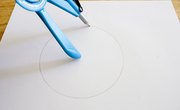
In classical geometry, the only permitted tools for constructing figures were a compass and an unmarked straightedge. With this, it was possible to perform a variety of operations, such as building equilateral triangles, squares, pentagons, hexagons and so on. Yet there are certain operations that simply cannot be done with these two tools alone, and one of these is constructing a 70 degree angle. However, if one is willing to step outside of the traditional compass and straightedge limitation, there are ways to accomplish this goal.
- Ruler
- Compass
- Protractor
Draw a straight line lengthwise across the middle of your sheet of paper, using the ruler as a straight edge. Then choose a spot on the line, about 4 inches from the edge of the paper, and draw a circle with the compass with a radius of 2.5 inches. Make sure the radius is as accurate as possible, and don't change the radius on the compass; you will need it at the same distance for the next step. Mark the center of the circle as point A and mark the point on the line where it crosses the circle closest to the edge of the paper point B.
Construct a 60 degree angle by placing the point of the compass at point B and sweeping the pencil to intersect the circle. Call this point C and draw a straight line from A to C. Angle CAB should be exactly 60 degrees.
Place the point of the compass at point C to brace the ruler's edge against. Then angle the ruler so that it passes through the circle to intersect the first line (now identified as line AB), somewhere outside the circle and near the center of the page. Notice that the ruler now crosses the circle twice, once at C and once on the way to where it intersects line AB.
Pivot the ruler around point C, adjusting the point at which it crosses line AB until you find the spot where it crosses AB exactly 2.5 inches away from where it crosses the circle. Mark this point on the line as point D. Angle CDB is exactly one third of angle CAB, or 20 degrees. Check it with the protractor.
Construct a line perpendicular to line AB and passing through line D. Start by drawing a circle centered on point D and then two larger circles centered on the points where the first circle intersects line AB. Connect the two points where these two larger circles intersect with a straight line, which should pass straight through D.
Mark as point E a point on this last line which is on the same side of line AB as point C. Because angle EDB is 90 degrees, and angle CDB is 20 degrees, angle EDC should be exactly 70 degrees. Check it with the protractor.
Things You'll Need
References
About the Author
Tom Kantain has been writing and editing in various forms for over 20 years. He has written a regular magazine column on the philosophy of games. Kantain holds a Master of Arts in philosophy as well as a Bachelor of Laws.
Photo Credits
Jupiterimages/Photos.com/Getty Images
